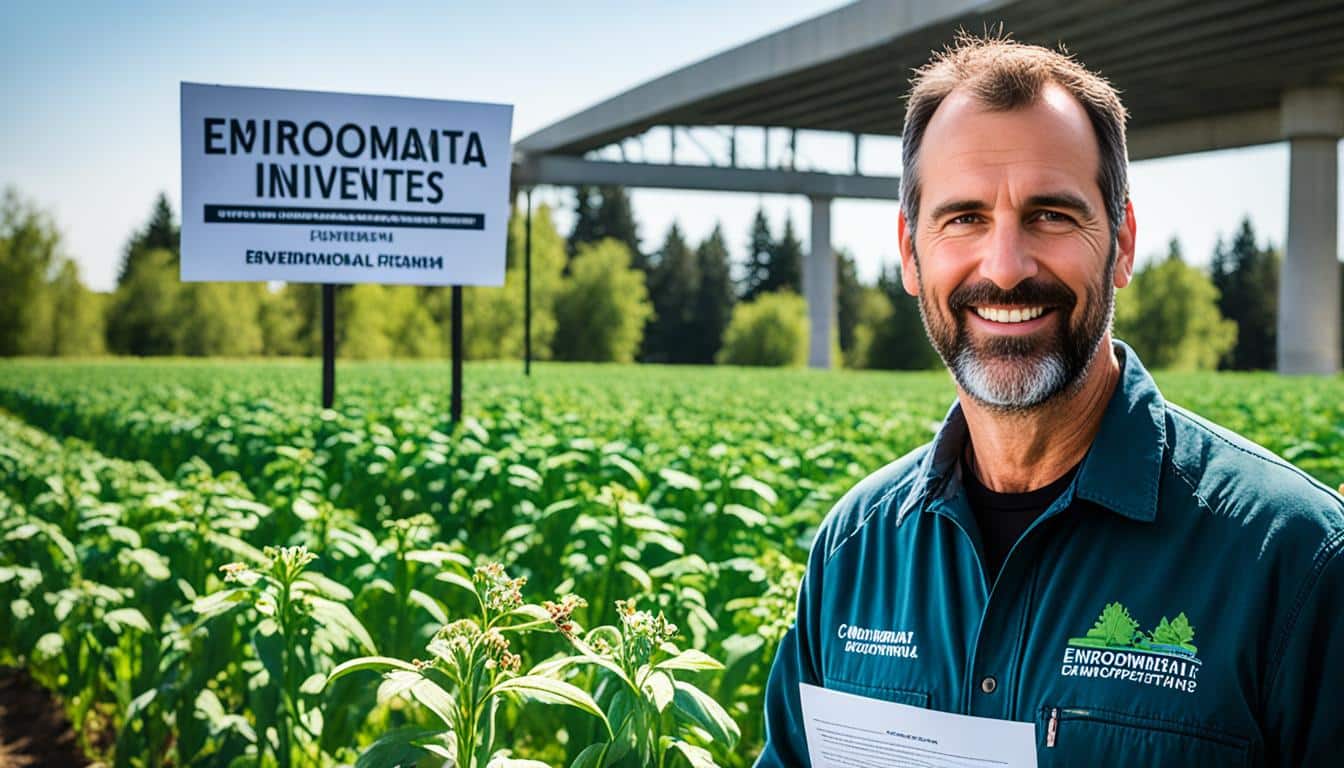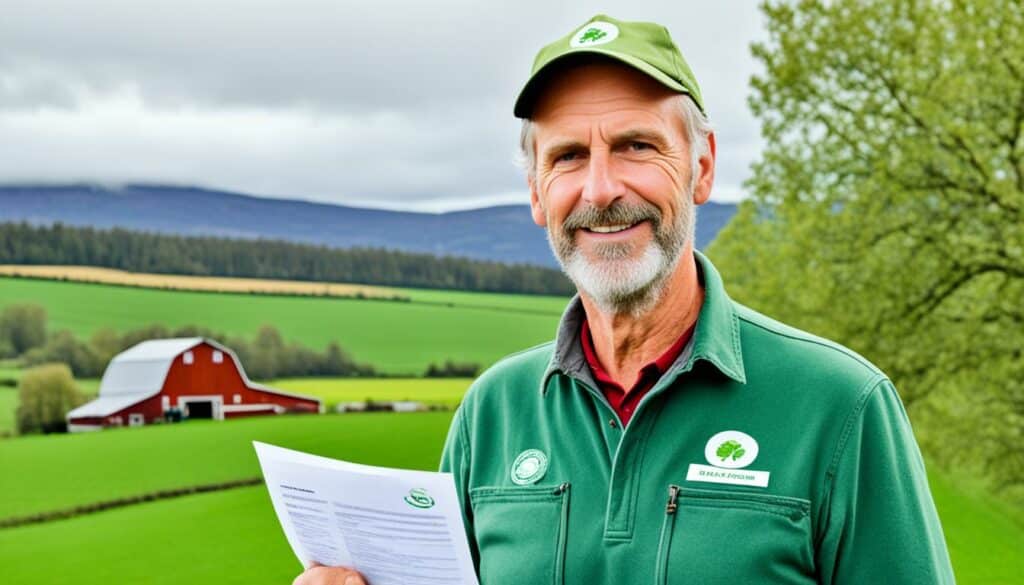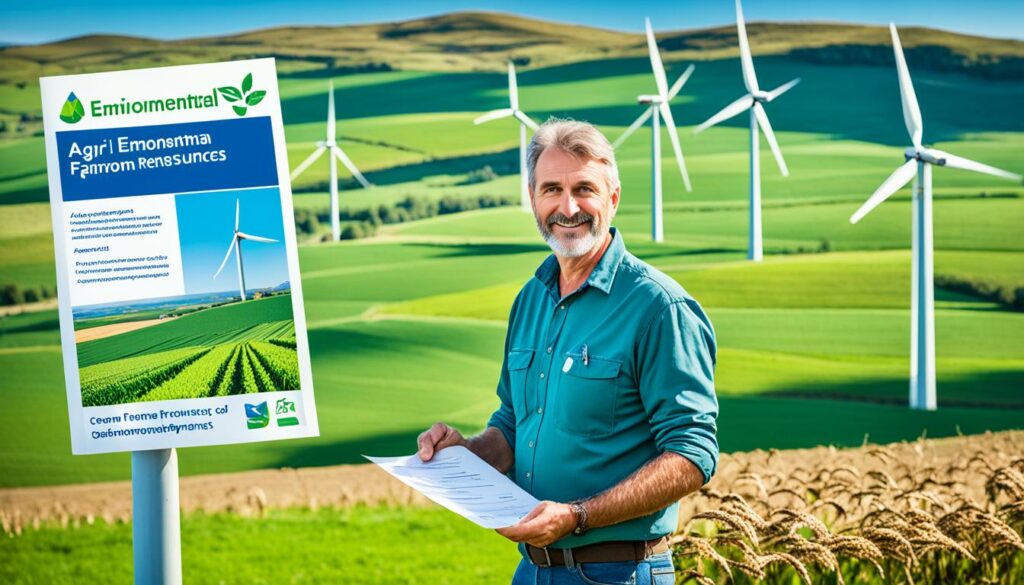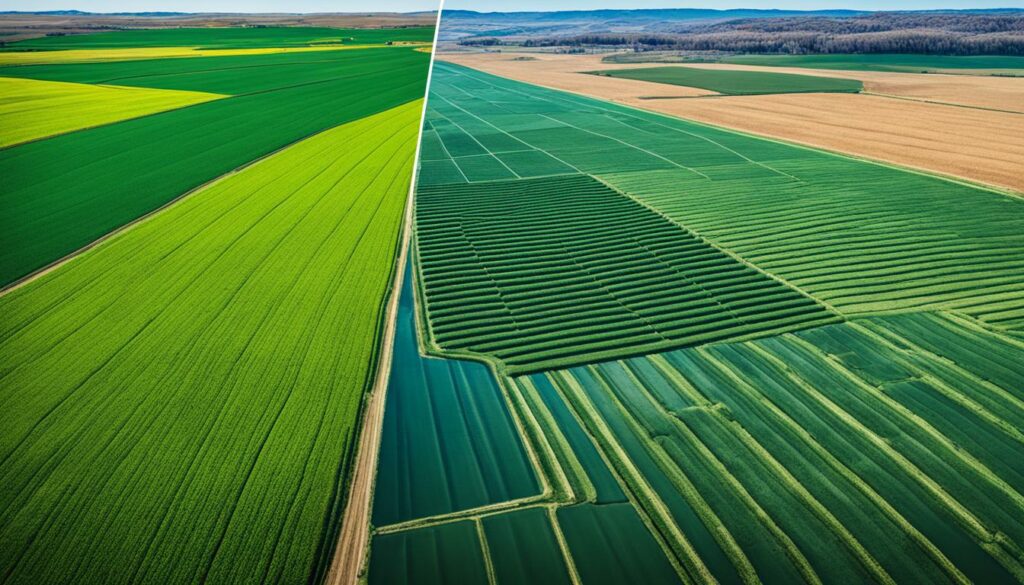Menu

Did you know that the government increased EQIP’s funding from $1.75 billion to a projected $2.025 billion by 2023? This shows strong support for farmers in sustainable farming. Government aid benefits the environment, boosts farming, and ensures economic growth.
These schemes aim to make water and air cleaner, improve soil health, help habitats, and fight droughts. Financial support and advice come from programmes like Conservation Technical Assistance and EQIP. EQIP, for instance, gives both money and advice through NRCS to meet each farm’s unique needs.
Farmers need to work with their local NRCS to make the most of these schemes. This can help prevent pollution, use nutrients better, and make soil healthier. It encourages farmers to adopt practices that help fight climate change by cutting down on emissions.
Farming is key to our food supply and the environment. But farming can also harm nature. The government has steps to help farmers do their job while protecting the environment.
It’s vital for farmers to lessen their impact on nature. They can help save soil, water, and air by following these steps. This means our food can keep growing without harming the planet.
The government has set up help like the EQIP for farmers. This program offers money and advice. It focuses on keeping water and air clean, making soil better, and protecting animals.
Other programs, such as the TSP and CTA, also support farmers. They offer the latest research and help them choose the best methods. Farmers can apply for these helps whenever they need, but they need to check for specific dates.
This help allows farmers to protect nature and keep their farms profitable. It’s a win-win situation for all. Our food grows, and the earth stays healthy.
The Environmental Quality Incentives Program (EQIP) helps farmers and forest landowners. It focuses on issues like water and air quality, soil health, and wildlife habitats. EQIP gives technical and financial help. Its aim is to boost farming while protecting the environment.

EQIP uses two ways to help: NRCS technical advice and money. NRCS doesn’t charge for advice. It gives practical help through experts. This support helps farmers reach their goals the right way.
EQIP helps pay for farming improvements. This includes managing irrigation, nutrients, and making habitats better. It also supports farming in new, better ways. Farmers might even get money upfront to start making these positive changes.
NRCS works with farmers to make plans that fit their needs. These plans handle things like keeping soil safe, saving water, and dealing with pests. The plans are contracts. They make sure that everyone does their part well.
EQIP is available in all 50 states and more. It works closely with local groups and councils. This makes sure the programme helps in the right way. It uses data since 2009 to do its job better.
EQIP supports making nature better. It helps with managing energy and forests, among other things. This includes taking care of important plants and making sure there’s a good balance in nature. The programme aims to spend money wisely to do good things for the Earth.
| Feature | Description |
|---|---|
| Technical Assistance | Provided at no cost by NRCS to offer science-based conservation guidance. |
| Financial Assistance | Covers a variety of conservation practices, with potential for advance payments. |
| Conservation Innovation Grants | Funds innovative approaches to conservation challenges. |
| Partnerships | Collaborates with State Technical Committees and Tribal Councils to set priorities. |
| Data Availability | Encompasses EQIP data from 2009 onwards, available for public review and analysis. |
The UK has many subsidies for sustainable farming. These help farmers make money while protecting the environment. It’s crucial for UK farmers to know and use these subsidies. They change how farming works, encouraging eco-friendly practices.
Programmes like the Sustainable Farming Incentive (SFI) and Countryside Stewardship (CS) are big helps. They give farmers money for using methods that don’t harm the planet. This support makes it easier for farmers to improve their practices. They work towards better environment protection and food production.
Farming in England is changing a lot because of recent rules. The old Basic Payment Scheme (BPS) is slowly stopping. It’s making way for new policies that focus on helping the Earth. The Environmental Land Management (ELM) scheme, part of the UK’s plan for a greener future, wants farms to have zero net carbon emissions by 2050.
The ELM scheme has three parts: Sustainable Farming Incentive, Local Nature Recovery, and Landscape Recovery. These parts help farmers care for the environment in different ways. Farmers also get different amounts of money now based on how much they help the land. This is to use resources better and help the environment more.
There are many UK farming subsidies that have worked well. The Countryside Stewardship scheme is a great example. It has helped farms be better for wildlife, keep soil healthy, and save water. This scheme shows that making money and helping the environment can go hand in hand. It benefits farmers both now and in the future.
There are always new ideas and help for farmers in these schemes. New policy papers and support keep coming. This support aims to make sure farms are sustainable and strong by 2028.
Eco-friendly farming grants help farmers use sustainable ways and get money to do it. These grants cover projects for saving water, improving soil, and adding renewable energy. Knowing how to apply and what schemes are available is key to getting these grants.

To get eco-friendly farming grants, farmers need to fill out a detailed form. They must show exactly how they plan to use green practices. This could mean better water and air, healthier soil, and more homes for wildlife. The NRCS can help for free, making sure plans are based on the newest science.
Several programmes are out there to help farmers go green. The EQIP is a main programme that gives out grants from the Conservation Innovation Grants. It helps with all kinds of projects, from better soil to smart ways to fight climate change. The NRCS has other schemes too, with different dates for each state’s chance to apply. Also, farmers can check the SARE and the Agriculture and Food Research Initiative for bigger long-term green projects.
Getting involved in environmental stewardship schemes is great for farmers. It brings them financial help and appreciation for their eco-friendly efforts. These programmes are key in pushing for better stewardship compliance farming. They directly help the planet.
By joining environmental stewardship schemes, farmers can help the planet a lot. They improve the health of the soil, the purity of water, and increase the number of living creatures. Following advice on farming practices leads to a more stable ecology and more money for farmers. These schemes also help farms deal better with the changing weather because of climate change. Also, programmes such as EQIP give farmers big help and advice to fix issues with nature. This includes making water and air cleaner and keeping the soil in better condition.
To enjoy the conservation schemes benefits, farmers must meet certain nature protection standards. This involves looking after the soil, managing water, and making homes for wildlife better. Taking part means working out conservation plans for their farm. The NRCS, along with Technical Service Providers, offers important advice and helps them with resources. It’s vital to keep following these guidelines for money and ongoing help. This ensures the environment continues to be looked after.
Green farming funding offers big chances for farmers to improve their practices. These funds support eco-friendly methods like organic farming and using renewable energy. They also help with managing water in a way that helps the planet. With this support, farmers can invest in sustainable practices that are good for nature and their pockets.
One key support is the Environmental Quality Incentives Program (EQIP). It helps by giving farmers both money and advice to tackle environment issues. This includes making water and air cleaner, saving water, improving soil, and protecting wildlife. NRCS is also there to offer big help and to plan these conservation steps carefully.

EQIP also lets farmers get money in advance, making it easier to start green practices quickly. This program helps cut down on pollution and better use of plant food. This means healthier soil and smarter farming methods for the planet. It aims to cut down on greenhouse gases and supports more eco-friendly farming finance.
EQIP has special parts like the High Tunnel and Organic Initatives. These are designed to help with different issues farmers face. For example, they help extend the growing season and make the air cleaner. Farmers can apply for these programs anytime, but each state has its own dates to decide who gets funding first.
There are also programs for planning, implementing, and checking on how well things are working. NRCS partners with experts to help farmers make smart choices for their land and resources. This advice is free and really helpful for making the right environmental choices for the farm.
| Initiative | Benefits |
|---|---|
| High Tunnel Initiative | Extends growing seasons, enhances soil quality |
| Organic Initiative | Supports transition to organic farming practices |
| Air Quality Initiative | Minimises emissions, improves air quality |
| Landscape Conservation Initiative | Focuses on region-specific conservation efforts |
| On-Farm Energy Initiative | Promotes energy efficiency and renewable energy use |
| Colorado River Basin Salinity Project | Reduces salinity levels, protecting water quality |
Green farming is about meeting people’s needs without harming nature. It aims to make our food, clothing, and the environment better. Using funding wisely, farmers can thrive for a long time, protect the planet, and make farming better for everyone.
Climate-friendly agriculture subsidies aim to help farmers lower the effects of climate change. They also help make farms more ready for extreme weather. Farmers get help like money directly, tax cuts, or lower costs for green farming methods and tools.
Different subsidies support various climate-conscious farming needs:
Getting farming subsidies means knowing what’s accepted and how to sign up. It often involves working with agriculture or conservation groups like NRCS.
The steps are:
By using these subsidies, farmers can help with tackling climate change. They get to support the environment and their budgets by doing things like cutting down on greenhouse gases and adapting to climate shifts.
Agri-environmental payments aim to encourage farmers to use methods that help the environment. It’s key for farmers to know how these payments are figured out. This way, they can aim to meet the rules and make their farms friendlier to nature.

Farmers have to follow certain eco-friendly rules to get these payments. Things like improving water and air quality, soil health, and homes for wildlife, count as meeting these standards. Taking part in the Environmental Quality Incentives Program (EQIP) helps with this. It sets up a process where farmers must keep their soil and wetlands in good condition. Not doing so could mean losing these benefits.
The money farmers get changes depending on what eco-friendly practices they use. They might get paid for each acre that’s taken care of in a way that helps nature. EQIP gives both know-how and financial help. This is through projects like the High Tunnel Initiative and the Organic Initiative. Experts called Technical Service Providers (TSP) guide the farmers in following the program well.
It’s key for farmers to know about the different parts of these programmes. This includes things like Conservation Planning Activities (CPAs) and looking at how well the land is doing after changes are made (CEMAs). Lots of farmland in the U.S. gets government help. This shows how important it is for farmers to do their bit for the environment.
Biodiversity conservation grants help increase ecological diversity. They fight off pests and diseases and better crop pollination. These schemes also foster healthier soil. Farmers can use these grants to grow more variety, like restoring habitats and saving native species.
Biodiversity is key in farming for several reasons. It makes farms more resilient to pests and diseases. It keeps the soil in good shape and helps the whole environment stay balanced. Farmers, with the help of these grants, build strong farming ecosystems that last and do well.
There are many chances for farmers to get grants that improve nature’s variety. To get these grants, you usually need a plan that shows how you’ll help biodiversity. A big program is the Environmental Quality Incentives Program (EQIP). It gives money and advice to fix natural problems. NRCS also offers free help, making sure farmers can make the best conservation choices.
| Programme | Benefits |
|---|---|
| Environmental Quality Incentives Program (EQIP) | Addresses water and air quality, improves soil health, and supports wildlife habitat conservation. Financial assistance includes advanced payments for qualifying farmers. |
| Conservation Reserve Program (CRP) | Annual rental payments for removing environmentally sensitive land from production, enhancing biodiversity and reducing soil erosion. |
| Conservation Innovation Grants | Stimulates the development of new conservation technologies, fostering innovative practices in biodiversity conservation. |
| Emergency Conservation Program (ECP) | Provides funding and technical assistance for restoring farmlands damaged by natural disasters, maintaining ecological balance. |
| Grassland Reserve Program (GRP) | Preserves grazing and pasture land, preventing land conversion and supporting native species preservation. |
Through these grants, farmers can do their part in saving our planet. They help create more diverse environments and encourage long-lasting farming practices.
Organic farming is getting a lot of support from governments worldwide. It sticks to sustainable ways and strict organic rules. Many countries give help to farmers that switch to organic or keep the high standards. This support helps build a strong and eco-friendly system for farming.

Going organic can be hard on the wallet. Because of this challenge, many countries help farmers change to organic ways. For example, India gives INR 30,000 per hectare for three years. This is for buying organic inputs. In Bali, Indonesia, there’s a fund of EUR 69.7 million yearly for organic fertilisers. They plan to increase this fund each year. Such help is vital. It allows more farmers to choose eco-friendly farming without big financial risks.
It’s not easy to keep up with the tough organic rules. But, governments help with this too. The EU pays for promoting organic goods. In Switzerland, farmers get direct eco payments, about 2.5 kCHF per hectare. This support is key. It makes sure that farms follow organic rules. It also helps the environment and cuts down on outside products.
Also, paying farmers for following organic steps leads to big wins for the planet. In Canada, for example, the partnership in agriculture funds food processors. This effort boosts organic farming’s whole system. These steps are vital for the future of eco-friendly and economically sound farming.
First, make sure to connect with your local NRCS office. The NRCS supports farmers and forest owners with programs like EQIP. These programs aim to tackle natural resource concerns and improve the environment. They help with water quality, air quality, and soil health.
Getting in touch with your local NRCS office is key. They provide free advice and help based on the latest research. This step helps you start understanding and applying for farm incentives. Note that there are specific dates for these funding cycles, so check with your local office.
Planning is vital for accessing incentives. NRCS specialists will visit and assess your farm. Then, they’ll work with you to create a plan that fits your farm’s needs. This may include different activities like planning, implementing, and monitoring conservation efforts.
With a plan in place, you can apply for specific financial help. For instance, there are grants for things like High Tunnel and Organic projects. EQIP also supports new conservation technologies through grants. Working with NRCS makes getting these incentives easier and comes with technical support.
Looking at various case studies, we find that government incentives greatly help in sustainable farming. These incentives help farmers choose methods that are good for the Earth. They also make farming more productive. These achievements show that money support and advice work together powerfully.

Many farms in the U.S. have seen their soil health get better because of EQIP. They used conservation tillage and grew different crops with its help. Financial aid and advice helped them do this well. High tunnel systems are also helping in many ways. They make water and air cleaner, bump up crop yields, and cut down the use of harmful chemicals.
These projects teach us some vital lessons. Careful planning and making full use of resources are key to getting the most from these projects. We also need to learn and change continually. To continue farming well, we must keep our practices up to date. The stories of success highlight the role of government help. This help has made our farms healthier and more enduring.
| Programme | Benefits | Example |
|---|---|---|
| EQIP | Improved water and air quality, increased soil health, enhanced wildlife habitats | High Tunnel systems for enhanced crop yields and reduced pesticide use |
| Conservation Innovation Grants | Pioneering new conservation technologies, efficient nutrient use, climate change mitigation | Implementation of renewable energy systems on farms |
Learning about the other perks of agriculture is key. It helps us see the wide influence of farming done right. By following environmental rules, farmers help everyone. They make the land and water cleaner and healthier. Agricultural practices can be good for people and nature too.
Farming is good for the planet in many ways. Using sustainable methods makes the air and water better. It also keeps the soil strong. The U.S. loses over a billion tons of soil to water each year. But, farms that act with the environment in mind can lower this number.
They also reduce how much harm commercial fertilisers do. This helps save rivers and lakes from being polluted. Areas can stay healthy for people and wildlife thanks to these practices.
Farming in a green way does more than help nature. It brings people closer and gets them to care for their land. This makes everyone happier. Farming well helps keep things like water and land in good shape for everyone. Good land equals strong communities.
There are big pluses for the economy too. Green farming can cut costs for farmers. For example, using certain methods reduces the average cost to manage crop waste by 31%. These are figures from corn farms using environmentally friendly tactics. And businesses that are green have seen their value go up a lot. This shows that doing right by the environment pays off in more ways than one.
Government incentives to improve farming’s impact on the environment are good but hard to use. These incentives bring great chances but many farmers find it tough to use them.

Farmers meet many problems when trying to use incentives. The hard process to apply is a big issue. This can stop them from trying at all. Also, it costs a lot to start new farming methods. Knowing and following all the rules can be hard too, slowing things down.
To beat these issues, a plan is needed. Asking for help from programmes like the NRCS is a good start. They provide expert advice and help. This makes it easier to understand what to do.
It’s important to keep the big picture in mind. Think about the better soil, water, and the farm’s strength against bad weather. This can keep farmers determined, despite the hard beginnings.
In 2015, the USDA put $5 million towards reducing pollution in Lake Erie. It showed that money problems are not always the main issue. In southern Africa, fitting new methods to how farmers work increased the success of these practices. This shows that finding the right approach and giving ongoing help is crucial.
Checking on these programmes regularly is also key. In 2012, Ohio found that their programme to trade water quality was working well. Addressing environmental issues early can help farmers win in both environment and money. It makes government incentives very important for keeping farming sustainable.
Getting help from the government to follow green rules in farming is a chance for farmers to improve. A study looked at around 18,000 papers about the impact of help given to farmers. From 577 articles looked at, 99 were picked to dive deeper into their info. It found that 36% of the programmes were about tech solutions, 32% about nature benefits, and 32% about social and economic help.
But, there are problems with how the money is being shared. A big part of the funds from EQIP and CSP doesn’t match the necessary green criteria. Since the IRA funded over $18 billion until 2031 for eco-friendly farming but capped the funds, there’s a ‘conservation cliff’. More than half of the projects from 2020 to 2022 don’t meet the green standards.
These issues show we need to make the rules more fair to cover important eco needs. In some places, like New York and Utah, most of the money farmers ask for doesn’t fit the IRA rules. If the IRA rules don’t change in the 2023 bill, many important eco projects might not get funded. So, to solve these issues, farmers need to plan carefully, use the support they can get, and push for fairer rules. Knowing this gives farmers a better chance to use the government’s help right, leading to greener farming.
The Environmental Quality Incentives Program (EQIP) gives you support. It helps with both money and advice to start sustainable farming. This makes your farm better for the planet.
Policies like EQIP and the Conservation Stewardship Program are there to help. They provide advice, money, and learning. This makes your farming methods better for the environment.
The EQIP offers help with both money and advice. It tackles issues like clean water and soil quality. Nature experts help you plan. You could get funds to put the plans into action.
Farmers in the UK can get many subsidies for being sustainable. Knowing about these can help improve your farm. They help your farm make money while being good to the environment.
To apply for grants, you need a detailed plan. This plan should show how you will use the grant for good farming. Programs like to see ideas for saving water, using clean energy, and bettering nature.
Joining these schemes might get you money. Plus, you’ll be seen as someone who cares for the Earth. They encourage good farming that protects nature and makes the soil and water better.
There’s money available for green farming. It helps with things like organic farming and using clean water. This funding makes good farming methods profitable.
Funding that helps the climate can be in the form of money, tax breaks, or cheaper services. They support farming that is kind to the Earth and ready for any weather change.
To get payments, you need to follow green rules or do certain good farming practices. How much you get can depend on your actions for the environment and the size of your green area.
Biodiversity is key for a healthy farm. It helps fight off pests, pollinates plants, and keeps the soil alive. Grants aim to improve farms by bringing back lost wildlife and using a mix of different crops.
To help with organic farming, there’s support for starting and keeping up with green practices. There are payments to cut the costs of going organic.
Contact your local NRCS office to begin with government help. They’ll make a plan for your farm that helps the environment. Also, they guide you to get financial and advice support.
Success stories show that with support, farms can do better for the Earth and make more money. They proof that good plans and using the help available can go a long way.
Working with these incentives makes the air, water, and soil cleaner. It shows you take care of nature and your community. It also helps your farm stay strong and healthy.
Getting started could be tricky with paperwork, initial costs, and the rules to follow. But, with a good plan, expert help, and support from NRCS, you can overcome these obstacles.